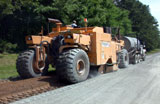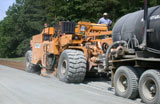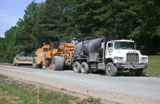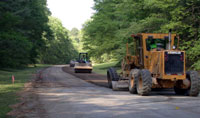 A severely deteriorated 30-mile section of the Natchez Trace Parkway southwest of Jackson, Mississippi, was recently rehabilitated through a process known as Full-Depth Reclamation (FDR). Originally constructed in the 1930s, The Trace, as it is known to locals, stretches for 444 miles through portions of Mississippi, Alabama, and Tennessee. Today it is administered by the National Park Service and serves as a popular scenic drive for hikers, campers, and bikers. Due to its popularity by recreational enthusiasts, the rehabilitation work had to be performed without closing the roadway to traffic – a formidable task – but one ideally suited for FDR.
A severely deteriorated 30-mile section of the Natchez Trace Parkway southwest of Jackson, Mississippi, was recently rehabilitated through a process known as Full-Depth Reclamation (FDR). Originally constructed in the 1930s, The Trace, as it is known to locals, stretches for 444 miles through portions of Mississippi, Alabama, and Tennessee. Today it is administered by the National Park Service and serves as a popular scenic drive for hikers, campers, and bikers. Due to its popularity by recreational enthusiasts, the rehabilitation work had to be performed without closing the roadway to traffic – a formidable task – but one ideally suited for FDR.
The Trace rehabilitation project was originally bid to use expanded asphalt technology (also known as foamed asphalt) but, due to constantly changing soil and moisture conditions, was discovered to only work well for the first 1,500 feet of the project. The contractor on the project chose to alter and dry up the soils by applying hydrated lime to the next 1,000 feet but was not able to obtain the necessary compaction and strength on the material. Rather than abandon the full-depth reclamation process altogether, the contractor switched to portland cement as the stabilizing agent for The Trace and the remainder of the 30-mile project was successfully completed without any delays!

Blending materials

Blending and compacting

Shaping and compacting
As in the case of The Trace, portland cement is the key to reconstructing flexible pavements that have failed. The incorporation of cement with the old surface and base course materials provides a practical, cost-effective means of strengthening worn-out pavements. The cement binds the particles together to form a stabilized base material capable of withstanding moisture infiltration and degradation. It increases the strength of the base without the need for removing the old material and hauling in large quantities of expensive new base materials. The success of The Trace project is paving the way for greater acceptance of FDR in Mississippi as an economical process for long-term road rehabilitation.